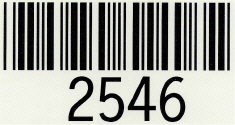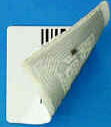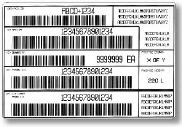 |
Meet DoD & EPC/Retail
specifications. |
|

Demand print & encoded.
|
 |
|
RFID
Basics |
| RFID stands for radio frequency identification. It
is an automatic identification technology whereby digital data
encoded in an RFID tag or “smart label” is captured by a
reader using radio waves. Put simply, RFID is similar to bar
code technology but uses radio waves to encode and capture data
to and from tags, rather than optically scanning the bar codes
on a label. RFID does not require tag or label to be seen to
read its stored data—that's one of the key characteristics of
an RFID system. However it is typical to find bar code and RFID
used together. |
Passive smart label RFID systems offer unique capabilities as an
automatic data capture system in that they:
|
Provide
error-free, wireless data transmission that is
battery-free and maintenance-free. |
|
Do
not require line-of-site scanners for operation. |
|
Allow
stored data to be altered during sorting or to capture
workflow process information. |
|
Work
effectively even in harsh environments with excessive
dirt, dust, moisture, and temperature extremes. |
|
RFID tags consist of an integrated circuit (IC) attached to an
antenna—typically a small coil of wires—plus some protective
packaging (like a plastic card) as determined by the application
requirements. RFID tags can come in many forms and sizes. Some
can be as small as a grain of rice. Data is stored in the IC and
transmitted through the antenna to a reader. RFID tags are
either “passive” (no battery)
or “active” (self-powered by a
battery). Tags also can be read-only (stored data can
be read but not changed), read/write (stored data can be altered
or re-written), or a combination, in which some data is
permanently stored while other memory is left accessible for
later encoding and updates. |
“Smart labels” are a particularly innovative form of RFID
tag and operate in much the same way. However, smart
labels consist of adhesive labels with an embedded ultra-thin
RFID tag “inlay” (the tag IC (integrated circuit)
plus antenna). Smart labels combine the read range and
unattended processing capability of RFID with the convenience
and flexibility of on-demand label printing. Smart labels also
can be pre-printed and pre coded for use. In on-demand
applications, the tag inlay can be encoded with fixed or
variable data and tested before the label is printed, while the
label can contain all the bar codes, text, and graphics used in
established applications. Smart labels are called “smart”
because of the flexible capabilities provided by the silicon
chip embedded in the tag inlay. A read/write smart label also
can be programmed and reprogrammed in use, following initial
coding during the label production process. |
A reader is basically a radio frequency (RF) transmitter and
receiver, controlled by a microprocessor or digital signal
processor. The reader, using an attached antenna, captures data
from tags then passes the data to a computer for processing. As
with tags, readers come in a wide range of sizes and offer
different features. Readers can be affixed in a stationary
position (for example, beside a conveyor belt in a factory or
dock doors in a warehouse), portable (integrated into a mobile
computer that also might be used for scanning bar codes), or
even embedded in electronic equipment such as print-on-demand
label printers. |
Information is sent to and read from RFID tags by a reader using
radio waves. In passive systems, which are the most common, an
RFID reader transmits an energy field that “wakes up” the
tag and provides the power for the tag to operate. In active
systems, a battery in the tag is used to boost the effective
operating range of the tag and to offer additional features over
passive tags, such as temperature sensing. Data collected from
tags is then passed through familiar communication interfaces
(cable or wireless) to host computer systems in the same manner
that data scanned from bar code labels is captured and passed to
computer systems for interpretation, storage, and action. |
Demand
Printed and Encoded RFID & Bar Coded Label Process
:
Click
Process
illustration and above data courtesy of Zebra Corporation. |
| *EPC
standard complaint |
|